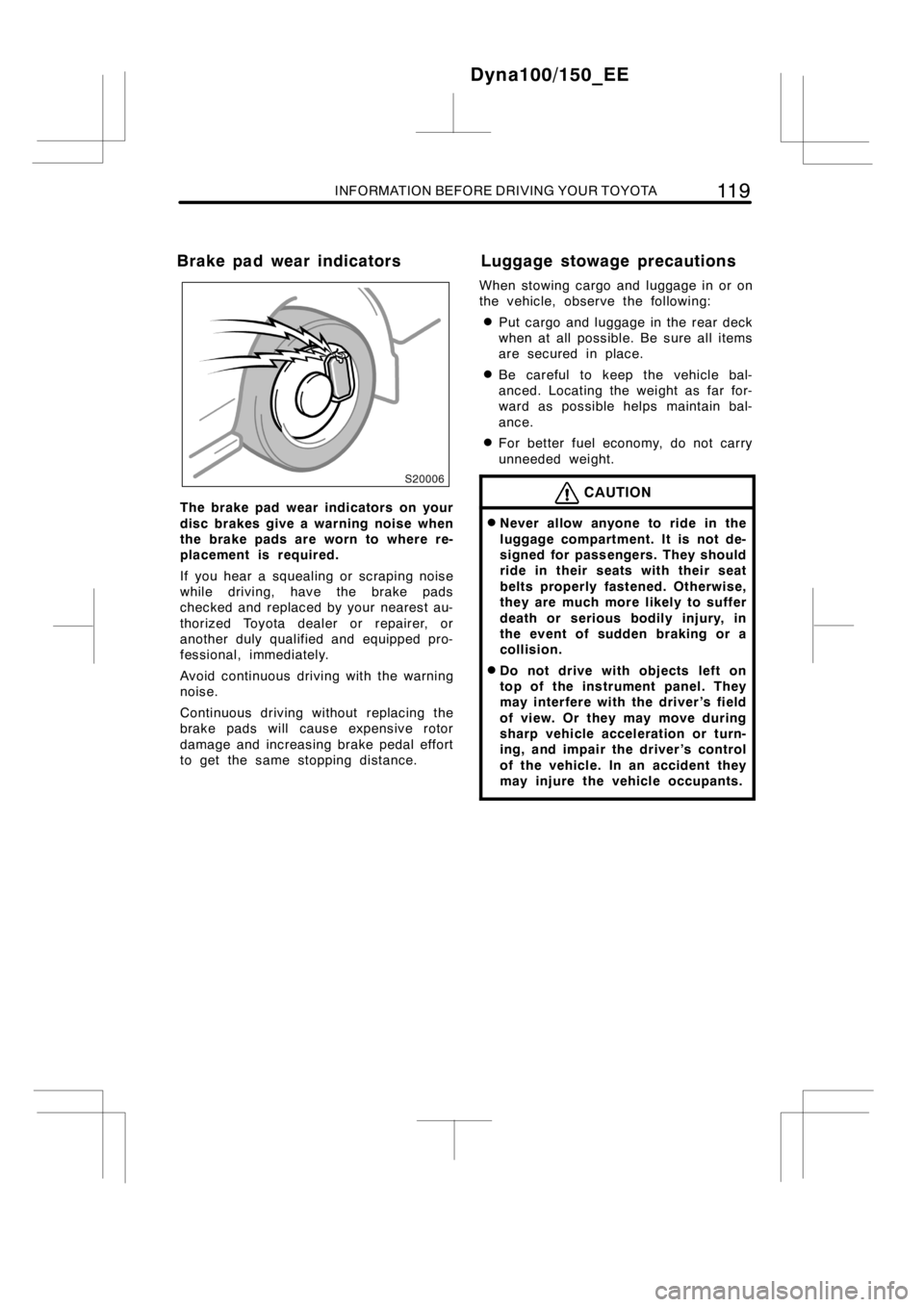Page 93 of 232
AIR CONDITIONING SYSTEM87
Air flow selector
Move the lever to select the vents used
for air flow.
1. Panel—Air flows mainly from the
instrument panel vents.
2. Bi−level—Air flows from both the floor
vents and the instrument panel vents.
3. Floor—Air flows mainly from the floor
vents.
4. Floor/Windshield—Air flows mainly
from the floor vents and windshield
vents.
5. Windshield—Air flows mainly from the
windshield vents.
For details about air flow selector settings,
see “Air flow selector settings” described
below.Air intake selector
Move the lever to select the air source.
1. Recirculate—Recirculates the air inside
the vehicle.
2. Fresh—Draws outside air into the sys-
tem.
Dyna100/150_EE
Page 108 of 232
102OTHER EQUIPMENT
The cup holder is designed for holding
cups or drink−cans securely.
To use the cup holder, pull it out com-
pletely.
CAUTION
DDo not place anything else other
than cups or drink−cans in the cup
holder, as such items may be
thrown about in the compartment
and possibly injure people in the
vehicle during sudden braking or in
an accident. If possible, cover hot
drinks to prevent burns.
DTo reduce the chance of injury in
case of an accident or sudden stop
while driving, keep the cup holder
closed when it is not in use.
NOTICE
Left−hand drive vehicles only—
Always stow the cup holder in the
instrument panel before opening the
engine access hole cover. If this is
not done, the cover will hit the cup
holder and damage it.
To use the box, pull on the handle.
CAUTION
To reduce the chance of injury in
case of an accident or a sudden stop,
always keep the auxiliary box closed
while driving.
Dyna100/150_EE
Cup holder Auxiliary box
Page 125 of 232

INFORMATION BEFORE DRIVING YOUR TOYOTA11 9
The brake pad wear indicators on your
disc brakes give a warning noise when
the brake pads are worn to where re-
placement is required.
If you hear a squealing or scraping noise
while driving, have the brake pads
checked and replaced by your nearest au-
thorized Toyota dealer or repairer, or
another duly qualified and equipped pro-
fessional, immediately.
Avoid continuous driving with the warning
noise.
Continuous driving without replacing the
brake pads will cause expensive rotor
damage and increasing brake pedal effort
to get the same stopping distance.When stowing cargo and luggage in or on
the vehicle, observe the following:
DPut cargo and luggage in the rear deck
when at all possible. Be sure all items
are secured in place.
DBe careful to keep the vehicle bal-
anced. Locating the weight as far for-
ward as possible helps maintain bal-
ance.
DFor better fuel economy, do not carry
unneeded weight.
CAUTION
DNever allow anyone to ride in the
luggage compartment. It is not de-
signed for passengers. They should
ride in their seats with their seat
belts properly fastened. Otherwise,
they are much more likely to suffer
death or serious bodily injury, in
the event of sudden braking or a
collision.
DDo not drive with objects left on
top of the instrument panel. They
may interfere with the driver’s field
of view. Or they may move during
sharp vehicle acceleration or turn-
ing, and impair the driver ’s control
of the vehicle. In an accident they
may injure the vehicle occupants.
Dyna100/150_EE
Brake pad wear indicators Luggage stowage precautions
Page 179 of 232

CORROSION PREVENTION AND APPEARANCE CARE173
CAUTION
DDo not splash or spill liquid in the
vehicle. Doing so may cause electri-
cal components etc. to malfunction
or catch fire.
DWhen cleaning the interior (espe-
cially instrument panel), do not use
polish wax or polish cleaner. The
instrument panel may reflect off the
windshield, obstructing the driver ’s
view and leading to an accident,
resulting in death or serious injury.
NOTICE
zDo not wash the vehicle floor with
water, or allow water to get onto
the floor when cleaning the vehicle
interior or exterior. Water may get
into audio components or other
electrical components above or un-
der the floor carpet (or mat) and
cause a malfunction; and it may
cause body corrosion.
zWhen cleaning the interior, do not
use polish wax or polish cleaner.
The instrument panel’s or other in-
terior part’s painted surface may be
damaged.
Vinyl interior
The vinyl upholstery may be easily
cleaned with a mild soap or detergent
and water.
First vacuum over the upholstery to re-
move loose dirt. Then, using a sponge or
soft cloth, apply the soap solution to the
vinyl. After allowing it to soak in for a few
minutes to loosen the dirt, remove the dirt
and wipe off the soap with a clean damp
cloth. If all the dirt do not come off, re-
peat the procedure. Commercial foaming−
type vinyl cleaners are also available
which work well. Follow the manufacturer ’s
instructions.
NOTICE
Do not use solvent, thinner, gasoline
or window cleaner on the interior.
Seat belts
The seat belts may be cleaned with
mild soap and water or with lukewarm
water.
Use a cloth or sponge. As you are clean-
ing, check the belts for excessive wear,
fraying, or cuts.
NOTICE
zDo not use dye or bleach on the
belts—it may weaken them.
zDo not use the belts until they be-
come dry.
Windows
The windows may be cleaned with any
household window cleaner.
Dyna100/150_EE
Cleaning the interior
Page 180 of 232

174CORROSION PREVENTION AND APPEARANCE CARE
Air conditioning control panel, audio
panel, instrument panel, console panel,
door switch panels, and switches
Use a soft damp cloth for cleaning.
Soak a clean soft cloth in water or luke-
warm water then lightly wipe off dirt.
NOTICE
zDo not use organic substances (sol-
vents, kerosene, alcohol, gasoline,
etc.) or alkaline or acidic solutions.
These chemicals can cause discol-
oring, staining or peeling of the
surface.
zIf you use cleaners or polishing
agents, make sure their ingredients
do not include the substances men-
tioned above.
zIf you use a liquid car freshener, do
not spill the liquid onto the ve-
hicle’s interior surfaces. It may con-
tain the ingredients mentioned
above. Immediately clean any spill
using the method mentioned above.
If you have any questions about the
cleaning of your Toyota, any authorized
Toyota dealer or repairer, or another
duly qualified and equipped profession-
al, will be pleased to answer them.
Dyna100/150_EE
Page 190 of 232
184DO−IT−YOURSELF MAINTENANCE: Introduction
Left side of the vehicle
(double cab models�)
Spare fuses
Instrument panel
�: See “Model code” on page vi in the
beginning of this manual if you are not
sure of your vehicle model.
Dyna100/150_EE
Page 209 of 232

DO−IT−YOURSELF MAINTENANCE: Electrical components203
Ty p e A
Good Blown
Ty p e B
Good Blown
Ty p e C
Good Blown
Instrument panel
If the headlights or other electrical
components do not work, check the
fuses. If any of the fuses are blown,
they must be replaced.
See “Fuse locations” on page 182 in Sec-
tion 7−1 for locations of the fuses.
Turn the engine switch and inoperative
component off. Pull the suspected fuse
straight out and check it.
Determine which fuse may be causing the
problem. The lid of the fuse box shows
the name of the circuit for each fuse. See
page 219 in Section 8 for the functions
controlled by each circuit.
Type A fuses can be pulled out by the
pull−out tool. The location of the pull−out
tool is shown in the illustration.
If you are not sure whether the fuse has
blown, try replacing the suspected fuse
with one that you know is good.
If the fuse has blown, push a new fuse
into the clip.
Only install a fuse with the amperage rat-
ing designated on the fuse box lid.
If you do not have a spare fuse, in an
emergency you can pull out the “CIG”,
“DOME” or “A/C” fuse, which may be dis-
pensable for normal driving, and use it if
its amperage rating is the same.
Dyna100/150_EE
Checking and replacing fuses
Page 225 of 232

SPECIFICATIONS219
Instrument panel
Left side of the vehicle
Fuses (type A)
1. CIG 15 A:Cigarette lighter
2. DOOR 30 A:Power door locksystem
3. IG1−NO.2 10 A:Gauges and meters,
service reminder indicators and warning
buzzer, back−up lights, back buzzer
4. WIP 30 A: Windshield wipers and
washer
5. A/C 10 A:Air conditioningsystem
6.IG110A:Back−up lights, back buzzer
7. TRN 10 A:Turn signal lights, emergen-
cy flashers
8. ECU−IG 10 A:Anti−lock brake system9. RR−FOG 10 A:Rear fog light
10. OBD 10 A:On−board diagnosissystem
11 . D O M E 1 0 A :Interior lights
12. ECU−B10A:Headlights, tail lights
13. TAIL 15 A:Tail lights, front position
lights, license plate lights, instrument
panel lights, rear fog light
14. H−LP LL 10 A (vehicle with daytime
running light system):Left−hand
headlight (low beam)
15. H−LP RL 10 A (vehicle with daytime
running light system):Right−hand
headlight (low beam)
16. H−LP LH 10 A (vehicle with daytime
running light system) or H−LP LH 15
A (vehicle without daytime running
light system):Left−hand headlight
(high beam)
17. H−LP RH 10 A (vehicle with daytime
running light system) or H−LP RH 15
A (vehicle without daytime running
light system):Right−hand headlight
(high beam)
18. HORN 10 A:Horns
19. HAZ 10 A:Emergency flashers
20. STOP 10 A:Stop lights
21. ST 10 A:Starting system
22.IG210A:SRS airbag system
23.A/CNO.210A:Air conditioning sys-
tem
24. SPARE 10 A:Spare fuse
25. SPARE 15 A:Spare fuse
26. SPARE 20 A:Spare fuse
27. SPARE 30 A:Spare fuse
28. FOG 15A:Fog light
29. F/HTR 30 A:Front heater
30. EFI1 10 A:Engine control system
31. ALT−S10A:Charging system, charg-
ing system warning light
32.AM210A:Engine switch
Dyna100/150_EE
Fuses